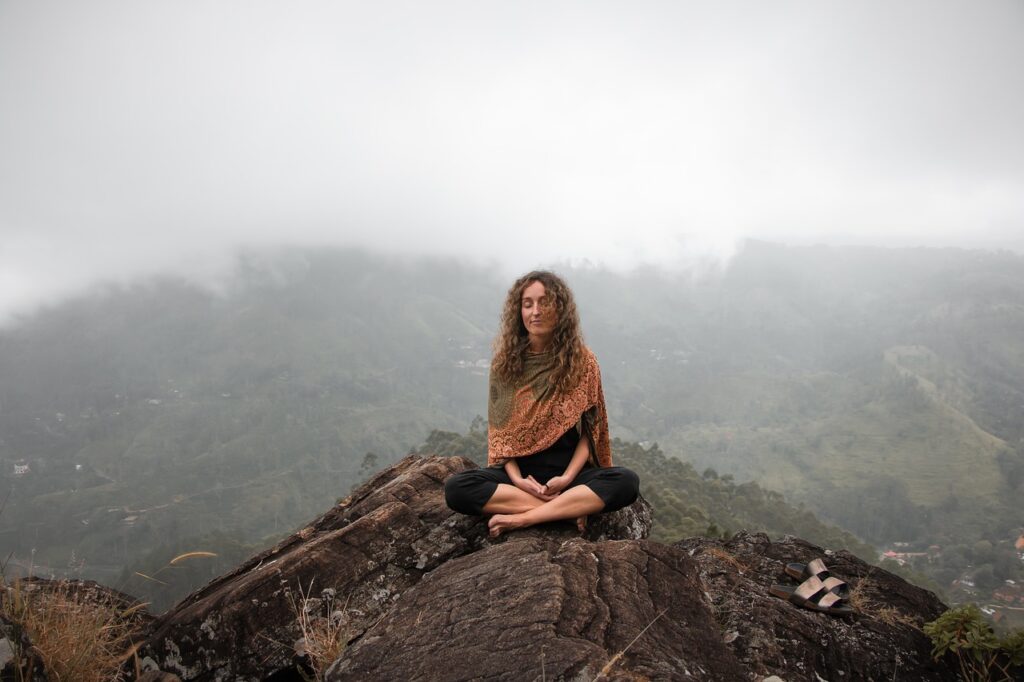Are you curious about how to seamlessly incorporate yoga philosophy into your everyday routine? Look no further, because we have the answers for you! Discover the transformative power of yoga philosophy and learn practical tips that will help you infuse its principles into your daily life. From incorporating mindfulness into mundane tasks to finding balance in the midst of chaos, this article will guide you on a journey to embrace the teachings of yoga in every aspect of your existence. Get ready to embark on a path towards greater peace, purpose, and harmony.
Practicing Yoga Asanas
Start with simple asanas
When it comes to practicing yoga asanas, it’s important to start with simple poses that are suitable for your level of flexibility and strength. Beginning with basic asanas allows you to build a strong foundation and gradually progress to more challenging poses. Simple asanas such as Mountain Pose (Tadasana), Child’s Pose (Balasana), and Warrior I (Virabhadrasana I) are great starting points. Remember to listen to your body and not push yourself beyond your limits.
Be consistent
Consistency is key when it comes to reaping the benefits of yoga asanas. It’s important to make time for your practice regularly, even if it’s just a few minutes each day. By committing to a consistent practice, you not only improve your physical strength and flexibility but also cultivate a sense of discipline and mindfulness. Whether you choose to practice in the morning or evening, find a time that works best for you and stick to it.
Include asanas in your daily routine
To fully integrate yoga asanas into your daily life, it’s beneficial to incorporate them into your routine. This can be as simple as doing a few poses in the morning to wake up your body or practicing a relaxing sequence before bedtime to unwind. By making asanas a part of your daily routine, you not only improve your physical well-being but also enhance your mental and emotional state. Whether it’s finding a quiet corner in your home or joining a yoga class, create a space where you can comfortably practice your asanas.
Breathing Techniques (Pranayama)
Learn different pranayama techniques
Pranayama, or yogic breathing, is an essential aspect of yoga practice. It involves controlling and regulating the breath to enhance physical and mental well-being. There are various pranayama techniques that you can learn, each with its own unique benefits. These techniques include Alternate Nostril Breathing (Nadi Shodhana), Ujjayi Breathing (Victorious Breath), and Kapalabhati (Skull Shining Breath). Take the time to explore different pranayama techniques and find the ones that resonate with you.
Incorporate pranayama in daily activities
Pranayama doesn’t have to be limited to your yoga mat. You can integrate these breathing techniques into your daily activities to maintain a calm and centered state of mind. For example, when you find yourself feeling stressed or anxious, take a moment to practice deep, conscious breathing. Inhale deeply through your nose, allowing your belly to expand, and then exhale slowly through your mouth. By incorporating pranayama into your daily activities, you cultivate a sense of mindfulness and find moments of peace amidst the busyness of life.
Focus on deep, conscious breathing
In pranayama practice, the emphasis is placed on deep, conscious breathing. This type of breathing involves taking slow, full breaths, filling your lungs to their maximum capacity. As you inhale deeply, you bring in fresh oxygen and vital energy into your body. As you exhale slowly, you release tension and toxins, allowing for relaxation and rejuvenation. By focusing on deep, conscious breathing, you connect with your body and mind, promoting overall well-being.

Meditation
Create a sacred space for meditation
Creating a sacred space for your meditation practice can enhance the quality of your experience. Find a quiet and peaceful area in your home where you can meditate without distractions. Decorate this space with items that hold personal significance to you, such as candles, crystals, or inspiring quotes. Make it a comfortable and inviting space that supports your meditation practice and allows you to connect with your inner self.
Start with short meditation sessions
If you’re new to meditation, it’s best to start with short sessions and gradually increase the duration as you become more comfortable. Begin with just a few minutes of focused breathing or using a mantra to anchor your attention. As you become more familiar with the practice, you can extend your meditation sessions to 10, 20, or even 30 minutes. Remember, the goal of meditation is not to completely empty your mind, but rather to observe your thoughts and find a sense of inner calm and clarity.
Use guided meditation if needed
Guided meditation can be a helpful tool for those who are new to meditation or struggle with maintaining focus during their practice. Guided meditations provide verbal instructions and prompts to help guide your awareness and keep you engaged. There are numerous guided meditation apps, websites, and videos available that cater to different needs and preferences. Experiment with different guided meditations until you find ones that resonate with you and support your meditation journey.
Living with Mindfulness
Practice being present in each moment
Mindfulness is the practice of being fully present and aware of your thoughts, feelings, and sensations in the present moment. It involves letting go of worries about the past or future and immersing yourself in the richness of the present. By practicing mindfulness, you cultivate a heightened sense of awareness and appreciation for life’s simple pleasures. Pay attention to your surroundings, savor the taste of your food, and fully engage in conversations with others. Each moment becomes an opportunity to experience life to its fullest.
Observe your thoughts and emotions without judgment
As you go about your day, take the time to observe your thoughts and emotions without judgment. Instead of reacting impulsively or getting caught up in negative patterns, pause and simply observe what arises within you. Notice any recurring thought patterns or emotions that may no longer serve you. By cultivating this non-judgmental awareness, you gain insight into your own mental and emotional landscape. This self-awareness allows you to consciously choose how you respond to different situations, leading to more clarity and peace of mind.
Engage in activities consciously
Living with mindfulness means bringing a sense of awareness and presence to everything you do. Whether it’s eating a meal, going for a walk, or engaging in work, approach each activity with intentionality and full engagement. Instead of multitasking or going through the motions on autopilot, focus on the task at hand. Notice the sensory experiences, the physical sensations, and the thoughts that arise as you engage in each activity. By practicing conscious engagement, even the simplest of activities can become opportunities for growth and connection.

Yoga Nidra
Learn and practice yoga nidra
Yoga Nidra, also known as yogic sleep, is a powerful practice that promotes deep relaxation and restoration. It involves lying down in a comfortable position while being guided through a series of relaxation techniques and visualization exercises. Yoga Nidra helps to release physical, mental, and emotional tension, and can be beneficial for reducing stress, improving sleep, and enhancing overall well-being. Take the time to learn and practice Yoga Nidra, either through guided recordings or by attending a class or workshop.
Make time for relaxation and deep rest
In our fast-paced and hectic lives, it’s crucial to prioritize relaxation and deep rest. Set aside dedicated time each day to allow your body and mind to unwind and rejuvenate. This can be as simple as taking a few minutes for deep relaxation after a yoga practice or incorporating a longer Yoga Nidra session into your routine. By making relaxation and deep rest a priority, you give yourself the opportunity to recharge and replenish your energy, leading to increased productivity and a greater sense of well-being.
Utilize yoga nidra for stress reduction
Stress has become an ever-present part of modern life, and finding effective ways to manage and reduce it is essential. Yoga Nidra offers a powerful tool for stress reduction by activating the relaxation response and calming the nervous system. When practiced regularly, it can help release tension, improve sleep, and promote a sense of inner peace. By utilizing Yoga Nidra as a tool for stress reduction, you can navigate life’s challenges with greater resilience and find a sense of calm amidst chaos.
Ahimsa (Non-violence) in Daily Interactions
Practice compassion towards yourself and others
Ahimsa, or non-violence, is a fundamental principle of yoga philosophy. It encompasses the practice of kindness, compassion, and empathy towards oneself and others. To integrate ahimsa into your daily life, cultivate a mindset of compassion towards yourself, acknowledging your strengths and embracing your imperfections. Extend this compassion to others by practicing empathy, understanding, and forgiveness. By embodying ahimsa in your interactions, you create a ripple effect of positivity and kindness in the world.
Avoid harmful actions, speech, and thoughts
In addition to practicing compassion, ahimsa also requires refraining from harmful actions, speech, and thoughts. Be mindful of how your actions may impact others and strive to act in ways that promote peace and harmony. Words have the power to uplift or hurt, so choose your words wisely and avoid gossip, criticism, or engaging in negative self-talk. Cultivate a mindset that seeks to uplift, support, and inspire others, fostering an environment of respect and love.
Promote peace and harmony in relationships
Ahimsa encourages fostering harmonious relationships built on respect, understanding, and open communication. Approach your interactions with others from a place of love and compassion, seeking to resolve conflicts peacefully and fostering a sense of unity. Listen attentively to others, practice empathy, and be open to understanding different perspectives. By promoting peace and harmony in your relationships, you contribute to a more peaceful and loving world.

Svadhyaya (Self-study) and Introspection
Reflect on your actions and their impact
Svadhyaya, or self-study, involves deep introspection and reflection on your thoughts, actions, and beliefs. Take the time to reflect on your interactions with others, your choices, and the impact they have on yourself and those around you. Ask yourself questions about your motivations, values, and areas for growth. By engaging in self-reflection, you develop a deeper understanding of yourself and can make conscious choices aligned with your authentic self.
Engage in self-inquiry and self-reflection
Self-inquiry is a practice of exploring the deeper aspects of your being and uncovering your true nature. Engage in practices such as journaling, meditation, or seeking guidance from a trusted mentor or therapist. Ask yourself meaningful questions about your purpose, values, and desires. Be open to exploring areas of discomfort or limiting beliefs and consider how they may be influencing your life. By engaging in self-inquiry and self-reflection, you embark on a journey of self-discovery and personal growth.
Learn from your mistakes and grow
Mistakes are an inherent part of being human, and embracing them as opportunities for growth is an important aspect of svadhyaya. Instead of dwelling on past mistakes or berating yourself, adopt a growth mindset that allows you to learn from them. Take responsibility for your actions, reflect on what you can do differently in the future, and make a commitment to personal growth. By embracing the lessons inherent in your mistakes, you cultivate resilience, wisdom, and a deeper understanding of yourself.
Satya (Truthfulness) in Communication
Speak and express yourself honestly
Satya, or truthfulness, is a principle that emphasizes honest and authentic communication. To integrate satya into your daily life, practice speaking and expressing yourself honestly, both with yourself and others. Be true to your values and beliefs, and avoid exaggeration, manipulation, or deceit. By speaking your truth, you foster trust and meaningful connections in your relationships.
Avoid gossip and misinformation
Gossip and spreading misinformation can cause harm and disrupt relationships. To embody satya, be mindful of the information you share and avoid engaging in gossip or spreading rumors. Instead, seek to engage in constructive and positive conversations that uplift and inspire others. By choosing to speak only what is true and necessary, you create an environment of integrity and authenticity.
Communicate with integrity and clarity
Effective communication is essential for cultivating healthy relationships and fostering understanding. When communicating with others, strive for clarity, compassion, and integrity. Listen actively and attentively, seeking to understand before responding. Be mindful of your tone and take responsibility for the impact your words may have on others. By communicating with integrity and clarity, you build trust, nurture connections, and create an environment of open and honest communication.
Practicing Santosha (Contentment)
Cultivate gratitude for what you have
Santosha, or contentment, involves finding joy and satisfaction in the present moment, rather than constantly longing for the future or dwelling on what you lack. Cultivate gratitude for what you have in your life, practicing appreciation for the simple pleasures, relationships, and experiences that bring you joy. By embracing contentment, you free yourself from the constant pursuit of external validation and find fulfillment in the richness of each moment.
Focus on the present moment, rather than longing for the future
In a world driven by goals and desires, it’s easy to constantly look towards the future for happiness and fulfillment. Practicing santosha means redirecting your focus to the present moment and finding fulfillment in the here and now. Embrace mindfulness and engage fully in each moment, savoring the experiences and connections that life offers. By letting go of attachment to future outcomes, you cultivate a sense of peace and contentment within yourself.
Find joy in simple pleasures
Contentment can be found in the simplest of pleasures. Take the time to appreciate the beauty of nature, savor a delicious meal, or engage in activities that bring you joy and relaxation. By consciously seeking out and finding joy in the little things, you cultivate an attitude of gratitude and contentment. Embrace the present moment and allow yourself to fully immerse in the happiness and fulfillment that can be found in the ordinary experiences of life.
Seva (Selfless Service)
Engage in acts of kindness and service
Seva, or selfless service, is the practice of offering our time, skills, and resources to help others without expecting anything in return. Engaging in acts of kindness and service not only benefits those in need but also brings a deep sense of fulfillment and purpose to our lives. Look for opportunities to volunteer in your community, support charitable organizations, or simply lend a helping hand to those around you. By practicing seva, you contribute to the well-being of others and create positive change in the world.
Volunteer for charitable organizations
Volunteering for charitable organizations is a powerful way to practice seva and make a meaningful impact in your community. Research local charities or nonprofit organizations that align with your values and interests, and offer your time and skills to support their mission. Whether it’s helping at a soup kitchen, tutoring children, or participating in environmental clean-ups, your efforts can make a significant difference. By volunteering, you not only contribute to the greater good but also experience a deep sense of fulfillment and connection.
Help those in need without expecting anything in return
The essence of seva is helping those in need without any expectation of personal gain. Look for opportunities to assist others, whether it’s offering a listening ear to a friend in distress, assisting an elderly neighbor with their groceries, or simply showing kindness to strangers. These small acts of selfless service have the power to uplift and inspire, creating a ripple effect of positivity in the world. By engaging in seva without expecting anything in return, you cultivate a compassionate and generous spirit.
In conclusion, integrating yoga philosophy into daily life involves incorporating practices such as yoga asanas, pranayama, meditation, mindfulness, yoga nidra, and embodying principles such as ahimsa, svadhyaya, satya, santosha, and seva. By embracing these practices and principles, you can experience a deeper connection to yourself and others, find inner peace and fulfillment, and navigate life’s challenges with grace and resilience. Remember that this journey is unique to you, so take your time, be gentle with yourself, and allow the wisdom of yoga to guide you on your path of self-discovery and growth.

